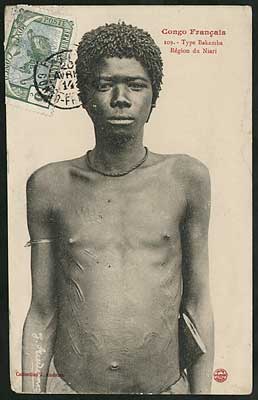
Section One
Central African Peoples through the Eyes of Western Photographers


Many late 19th- and early 20th-century images depicted Africans in rigid frontal and profile poses. These were called "type" photographs and were used as scientific evidence for the race theories of the time period. Scholars linked physical--in particular facial--features and the shape of the skull to a person's intellect and personality. According to influential British scientist Charles Darwin (1809-1882), human physical characteristics and cultural forms were the end products of a long chain of evolution. In this scheme, which has since been proven spurious, many Africans occupied a lower level on the evolutionary ladder, while Caucasians were placed at the top.
Image makers also engaged in ethnographic documentation. They depicted African village settings, masquerades and various aspects of material culture. In the late 19th century, frozen poses of photographic subjects and meticulous staging of scenes were common due in part to the long exposure time required to take a photograph. Even after cameras and film were capable of capturing movement, some of the pictorial conventions that characterized early "type" and ethnographic photography continued to be employed, which accounts for the constructed nature of many of the photographs.
Pictured above
Kamba "type," Niari River region, French Congo
Jean Audema (mid-19th to early 20th century)
c. 1900, postcard, collotype
Published by Impriméries Réunis de Nancy, France
Postmarked April 20, 1914
Eliot Elisofon Photographic Archives
National Museum of African Art
Smithsonian Institution
1985-140019.02